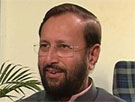United Nations, Sep 24 With a slogan of “Development without destruction”, India’s message to the UN Climate Change Summit is that it will take on the twin challenges of fighting poverty and climate change.
India will have to increase its energy consumption if it is to significantly improve the lives of its people, but it will try to achieve that goal while also reducing carbon emissions, Environment Minister Prakash Javadekar told the summit Tuesday.
He pointed out that in countries that have achieved a human development index (HDI) of 0.9 or higher, the per capita energy consumption was at least 2.5 tonnes oil equivalent per year, while India’s is only a quarter of that.
“In other words, with today’s technologies and living standards, the energy consumption in India would need to increase by four times as India’s HDI increases from the current value of 0.5 to a value of 0.9,” he said. “The key challenge therefore is to enable this higher energy consumption at a cost that people are willing and able to pay, and with lower carbon intensity.”
But he gave the assurance that “we are fully committed to achieving our voluntary goal for reducing emission intensity of its GDP by 20-25 percent by 2020 over 2005 level”.
“Our prime minister has announced an ambitious programme of ‘Make in India’ with ‘Zero Defect and Zero Effect’. Our slogan therefore is ‘Development without Destruction’,” he added.
The minister took aim at a contentious aspect of the climate change debate, where many focus on the total carbon output of nations as a whole and not on that of individual citizens and ignore the link between low energy consumption and poverty. Thus, India is sometimes seen as a big polluter compared to countries with smaller populations, but whose per capita emissions are several times that of an Indians. The key dilemma, therefore, is to improve living conditions of Indian people — of which the UN’s HDI is a measure — while keeping down the level of pollution that could arise from increased energy consumption.
US President Barack Obama, who spoke earlier in the day, dealt with this issue while acknowledging that the US had contributed to the climate crisis. He said the US was now committed to “helping more nations skip past the dirty phase of development, using current technologies, not duplicating the same mistakes and environmental degradation that took place previously”.
Javadekar said, “If the developed world walks the talk, then we can certainly achieve the targets that we have set ourselves collectively (to fight climate change).”
Outlining the Indian government’s plans to increase energy production, Javadekar emphasised renewable sources of energy and energy efficiency: “Doubling the installed wind energy capacity over the next five years, increasing installed solar capacity to over 20,000 MW by 2020, achieving 10,000 MW of energy efficiency savings by 2020 are only some of the initiatives currently being pursued.”
A symbol of Prime Minister Narendra Modi’s commitment to combating climate change was the renaming of his ministry as “Ministry of Environment, Forests and Climate Change”, Javadekar said. He outlined some of the steps taken by the Modi government on the environment front:
– Doubling of the clean energy cess from Rs.50 per tonne to 100 Rs. per tonne of coal to raise more revenue for clean energy technologies with the fund now having close to $6 billion;
– Allocating over $15 million to the “National Adaptation Fund”;
– Providing $80 million for ultra mega solar projects and $16 million for the development of 1 MW solar parks on the banks of canals;
– Allocating $100 million for a new scheme, “Ultra-Modern Super Critical Coal-Based Thermal Power Technology”;
– A $6 billion-programme for afforestation;
– The “One hundred Smart Cities” with integrated policies to reduce the vulnerability and exposure of urban areas to climate change and also to improve their energy efficiency.

